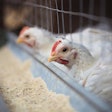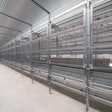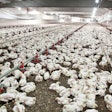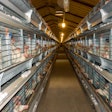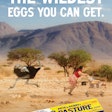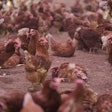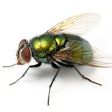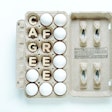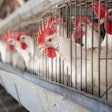There is concern that alternatives to caged systems should meet current and anticipated welfare standards. It is critical to establish the permissible stocking density, feed and watering space so that equipment manufacturers can design and install aviaries which are compliant with existing standards.
During 2008, standards have been issued by United Egg Producers (UEP) and Humane Farm Animal Care (HFAC). It is presumed that the American Human Society will also issue their standards.
Specific values are apparently determined by panels of experts in the field of welfare and management, based on scientific data in peer review journals. The genesis for U.S. standards is apparently European Union Regulation 1974/75 which is the basis of the design of modules from Europe.
In preparing feasibility studies for clients and advising equipment manufacturers, it is evident that there is some confusion in defining standards relating to allowances for available floor and perch space, litter area and the level and measurement of illumination.
Table: Comparison of welfare standards for aviary systems
The preliminary standards prepared by the American Humane Society were derived from UK standards which in turn were influenced by the European Union (EU) directive. Similarities between the Certified Humane and the proposed American Humane Certified values can be explained by commonality on advisory panels and the influence of individuals who have worked for both organizations.
Selecting a parameter such as space allowance for hens has a marked influence on the design of equipment, the effective stocking density and hence capital and operating costs.
Floor area opinions
Discussion with representatives of UEP and HFAC in late June provided opinions that both floor area and accessible space on the tiers of the aviary modules should be incorporated into the calculation of available area. This follows the EU practice of defining unrestricted floor areas and walk areas on tiers that are at least 12-inches wide and with an 18-inch head room (dimensions converted from the metric equivalents).
The appended table documents the standards among the three certifying agencies in comparison to the EU directive. There is close similarity in the U.S. standards but extracting the information on which the spreadsheet is based required individual contact with representatives of the three organizations to obtain supplementary explanations to achieve clarity.
It is strongly recommended that complete harmonization should be adopted among the agencies establishing standards to facilitate the design of systems by suppliers and selection by producers.
Given that the cost of aviary systems together with housing and ancillary structures are in the region of $30/hen, certification of farms and acceptability by clients will be dependent on a "level playing field". There is no point in each of the certifying agencies to "out-welfare" each other. There must be consistency in standards and if there is any deviation, this should be based on scientific principles rather than the whim of committees, certifying agencies or auditors.
It is also necessary that the certifying agencies prepare clear, concise and non-ambiguous standards. It is presumed that the problem with attempting to interpret written standards relates to the fact that the scientific committees are lacking in their individual and collective practical experience and familiarity with the design and construction of housing and equipment and management of flocks at the commercial level.
No non-compliant compromise
There should not be any compromise of standards by grandfathering of existing non-compliant installations. If it is considered inhumane to deviate from a published standard then it is unacceptable to accept a sub-standard unit unless adjustments are made in stocking density or equipment is modified.
It is further suggested that there should be greater transparency in the derivation of standards. Committees should include disinterested scientists and veterinarians involved in production.
Committees should include term limits to facilitate rotation of membership and as with auditors should be required to conform to ethical and procedural restraints and show evidence of frequent field contact with flocks and production systems. It is critical to avoid conflicts of interest which arise when committee members serve on different panels advising certifying agencies in addition to multinational QSR's.
A further area of concern is represented by individual members receiving research support provided by commercial entities which may benefit from subjective opinions which are translated into standards.



